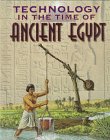
Judith Crosher. Technology in the Time of Ancient Egypt. Austin: Raintree Steck-Vaughn Publishers, 1998. 48 pp. Grades 4-6, ages 9-12. $25.69 (cloth), ISBN 978-0-8172-4875-8.
Reviewed by Emily Teeter (Associate Curator, Oriental Institute Museum, University of Chicago)
Published on H-AfrTeach (February, 1999)
A commonly asked question in regard to Egyptian artifacts and architecture is, "How did they do that?" This well-researched book is directed at readers age 9-12, but it will answer anyone's questions. The text addresses the topics of food, cloth, buildings, crafts (stone working, glass making, metalwork, pottery, leather, reeds, and rush work), travel (boats and chariots), warfare, writing and painting, health and beauty, the afterlife, and technology through time (a timeline of technological advances), and it concludes with a glossary, suggestions for further reading and an index. Many of the illustrations are ancient artifacts while others are details of Egyptian tomb paintings. The rest are original diagrams of tools in use, techniques (such as the excellent discussion of the lost wax process), and exploded diagrams (such as that of a ship and chariot wheels). This commissioned art is excellent as well as stylish, and it does much to clarify the text. Instructors will find this to be an excellent resource not only for its clarity, but also because most chapters are accompanied by practical projects such as using light to tell time, weaving tablets, and making a reed mat and a cartonnage mask.
There are only a few points with which one may find fault. One is the comment that the Egyptians made "paper that was used all over the Western world for hundreds of years" (p. 4), which implies that papyrus was used in the New World as well as the old. The book was written by a British author and some of the terminology may not be easily understood by American audiences, such as "bradawl" (p. 17), "spirit level" (p. 18) and "powder paints" (p. 43). A few diagrams have minor mistakes. That of the Great Pyramid (p. 19) indicates that three blocks were slid down the Grand Gallery, when in fact the three blocks are portcullis blocks that were lowered into the passage to the King's Chamber. The carpentry joint shown on page 31, labeled a dovetail joint, is a mortise and tenon joint. The comment that Egyptian doctors "made casts for broken limbs by mixing flour and cream, which set hard" (p. 40) is a confusion for the ancient practice of simply splinting broken limbs.
In spite of these small quibbles, the book is very good. It clearly answers the most commonly asked questions about ancient Egyptian technology and it will prove to be a good resource for classroom projects.
Copyright (c) 1999 by H-Net, all rights reserved. This work may be copied for non-profit educational use if proper credit is given to the author and the list. For other permission, please contact H-Net@h-net.msu.edu.
If there is additional discussion of this review, you may access it through the network, at: https://networks.h-net.org/h-afrteach.
Citation:
Emily Teeter. Review of Crosher, Judith, Technology in the Time of Ancient Egypt.
H-AfrTeach, H-Net Reviews.
February, 1999.
URL: http://www.h-net.org/reviews/showrev.php?id=2750
Copyright © 1999 by H-Net, all rights reserved. H-Net permits the redistribution and reprinting of this work for nonprofit, educational purposes, with full and accurate attribution to the author, web location, date of publication, originating list, and H-Net: Humanities & Social Sciences Online. For any other proposed use, contact the Reviews editorial staff at hbooks@mail.h-net.org.



